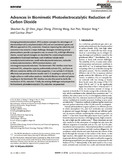Zitierlink:
http://dx.doi.org/10.25819/ubsi/10322| DC Element | Wert | Sprache |
|---|---|---|
| dc.contributor.author | Yang, Nianjun | - |
| dc.date.accessioned | 2023-05-15T13:44:12Z | - |
| dc.date.available | 2023-05-15T13:44:12Z | - |
| dc.date.issued | 2022 | de |
| dc.description | Finanziert im Rahmen der DEAL-Verträge durch die Universitätsbibliothek Siegen Autor*innen: Shaohan Xu, Qi Shen, Jingui Zheng, Zhiming Wang, Xun Pan, Nianjun Yang, Guohua Zhao | de |
| dc.description.abstract | Emerging photoelectrocatalysis (PEC) systems synergize the advantages of electrocatalysis (EC) and photocatalysis (PC) and are considered a green and efficient approach to CO2 conversion. However, improving the selectivity and conversion rate remains a major challenge. Strategies mimicking natural photosynthesis provide a prospective way to convert CO2 with high efficiency. Herein, several typical strategies are described for constructing biomimetic photoelectric functional interfaces; such interfaces include metal cocatalysts/semiconductors, small molecules/semiconductors, molecular catalysts/semiconductors, MOFs/semiconductors, and microorganisms/semiconductors. The biomimetic PEC interface must have enhanced CO2 adsorption capacity, preferentially activate CO2, and have an efficient conversion ability; with these properties, it can activate C=O bonds effectively and promote electron transfer and C-C coupling to convert CO2 to single-carbon or multicarbon products. Interfacial electron transfer and proton coupling on the biomimetic PEC interface are also discussed to clarify the mechanism of CO2 reduction. Finally, the existing challenges and perspectives for biomimetic photoelectrocatalytic CO2 reduction are presented. | en |
| dc.identifier.doi | http://dx.doi.org/10.25819/ubsi/10322 | - |
| dc.identifier.uri | https://dspace.ub.uni-siegen.de/handle/ubsi/2515 | - |
| dc.identifier.urn | urn:nbn:de:hbz:467-25158 | - |
| dc.language.iso | en | de |
| dc.rights | Namensnennung 4.0 International | * |
| dc.rights.uri | http://creativecommons.org/licenses/by/4.0/ | * |
| dc.source | Advanced science ; 9 (31), article number 2203941. - https://doi.org/10.1002/advs.202203941 | de |
| dc.subject.ddc | 620 Ingenieurwissenschaften und zugeordnete Tätigkeiten | de |
| dc.subject.other | CO2 conversion | en |
| dc.subject.other | Electron transfer | en |
| dc.subject.other | Photoelectrocatalysis | en |
| dc.subject.other | Reaction mechanisms | en |
| dc.subject.other | CO2-Umwandlung | de |
| dc.subject.other | Elektronenübertragung | de |
| dc.subject.other | Photoelektrokatalyse | de |
| dc.subject.other | Reaktionsmechanismen | de |
| dc.subject.swb | Kohlendioxid | de |
| dc.subject.swb | Biomimetische Reaktion | de |
| dc.title | Advances in biomimetic photoelectrocatalytic reduction of carbon dioxide | en |
| dc.type | Article | de |
| item.fulltext | With Fulltext | - |
| ubsi.publication.affiliation | Institut für Werkstofftechnik | de |
| ubsi.source.doi | 10.1002/advs.202203941 | - |
| ubsi.source.issn | 2198-3844 | - |
| ubsi.source.issued | 2022 | de |
| ubsi.source.issuenumber | 31 | de |
| ubsi.source.pages | 24 | de |
| ubsi.source.place | Weinheim | de |
| ubsi.source.publisher | Wiley-VCH | de |
| ubsi.source.title | Advanced science | de |
| ubsi.source.volume | 9 | de |
| ubsi.subject.ghbs | ZLT | de |
| Enthalten in den Sammlungen: | Geförderte Open-Access-Publikationen | |
Dateien zu dieser Ressource:
| Datei | Beschreibung | Größe | Format | |
|---|---|---|---|---|
| Advances_in_biomimetic_photoelectrocatalytic_reduction.pdf | 4.85 MB | Adobe PDF |  Öffnen/Anzeigen |
Diese Ressource ist urheberrechtlich geschützt. |
Seitenansichten
481
checked on 28.11.2024
Download(s)
133
checked on 28.11.2024
Google ScholarTM
Prüfe
Prüfe
Diese Ressource wurde unter folgender Copyright-Bestimmung veröffentlicht: Lizenz von Creative Commons


